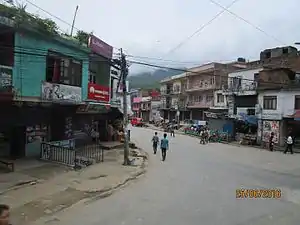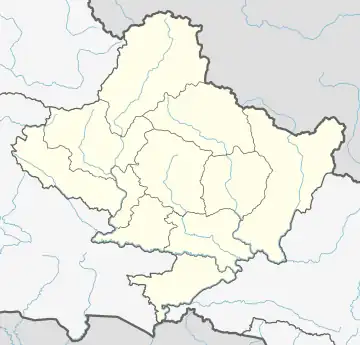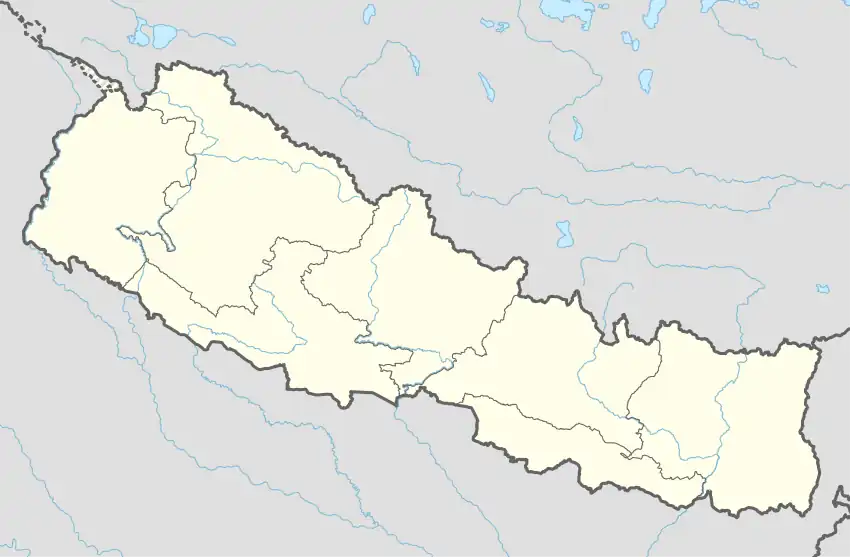Aanbookhaireni
आँबुखैरेनि गाउँपालिका | |
|---|---|
 The starting point of Anbukhaireni Gorkha Road | |
 Aanbookhaireni  Aanbookhaireni | |
| Coordinates: 27°54′13″N 84°32′24″E / 27.9037°N 84.5399°E | |
| Country | |
| Province | Gandaki Province |
| District | Tanahu District |
| Wards | 6 |
| re-established | 2017 |
| Government | |
| • Type | Rural Municipality |
| • Chairperson | Mr. Gir Bahadur Thapa |
| • Deputy Chairperson | Mrs. Pushpa Devi Shrestha |
| Area | |
| • Total | 128 km2 (49 sq mi) |
| Population (2011) | |
| • Total | 20,768 |
| • Density | 160/km2 (420/sq mi) |
| Time zone | UTC+5:45 (NST) |
| Website | http://anbukhairenimun.gov.np/ |
Anbu Khaireni (also Aanbu Khaireni, Aanboo Khaireni or Anbukhaireni) (Nepali: आँबुखैरेनि गाउँपालिका) is a rural municipality in Tanahu District in the Gandaki Province of central Nepal which was established in 2015. At the time of the 1991 Nepal census it had a population of 11,450 people living in 2234 individual households. In the census of 2011 the municipality has 16,382 inhabitants.[1][2]
In 2017, the Government of Nepal restructured the local level bodies into 753 new local level units,[3][4] at that time the former Anbu Khaireni Municipality restableshed as a rural municipality with same name. The former Chhimkeshwari and Deurali VDCs also were incorporated with this new rural municipality. The rural municipality rearranged into 6 wards.[5]
The Andhi Khola River flows nearby. On its right bank is Satrasaya Phant, which was once a dense forest.[6] The Anpu copper mines lie within a kilometre from the village.[7]
To promote local culture Anbu khaireni has one FM radio station Mero Sathi FM - 107.2 MHz which is a Community radio station.And newly opened hospital Alisha healthcare polyclinic Pvt ltd.
Demographics
At the time of the 2011 Nepal census, Anbu Khaireni Rural Municipality had a population of 20,840. Of these, 65.7% spoke Nepali, 15.1% Gurung, 13.3% Magar, 1.7% Newar, 1.4% Bhujel, 0.8% Bhojpuri, 0.4% Tamang, 0.3% Maithili, 0.2% Hindi, 0.2% Urdu, 0.1% Bengali, 0.1% Rai, 0.1% Sign language, 0.1% Thakali and 0.1% other languages as their first language.[8]
In terms of ethnicity/caste, 30.8% were Gurung, 22.9% Magar, 9.2% Chhetri, 8.3% Newar, 7.8% Hill Brahmin, 5.8% Gharti/Bhujel, 5.4% Kami, 2.1% Damai/Dholi, 1.1% Badi, 1.0% Thakuri, 0.9% Tamang, 0.7% Chepang/Praja, 0.6% Musalman, 0.6% Sarki, 0.4% Kumal, 0.3% Kathabaniyan, 0.3% Rai, 0.2% Teli, 0.2% Tharu, 0.2% Yadav, 0.1% Bengali, 0.1% Hajam/Thakur, 0.1% Kalwar, 0.1% Mallaha, 0.1% Sanyasi/Dasnami, 0.1% Thakali and 0.6% others.[9]
In terms of religion, 76.8% were Hindu, 18.6% Buddhist, 2.9% Christian, 0.5% Bon, 0.5% Muslim, 0.1% Prakriti and 0.6% others.[10]
In terms of literacy, 75.0% could read and write, 1.7% could only read and 23.1% could neither read nor write.[11]
References
- ↑ "Nepal Census 2001", Nepal's Village Development Committees, Digital Himalaya, archived from the original on 12 October 2008, retrieved 15 November 2009.
- ↑ "Municipal profiles". www.muannepal.org.np. Archived from the original on 7 January 2014. Retrieved 6 June 2022.
- ↑ "New local level structure comes into effect from today". www.thehimalayantimes.com. The Himalayan Times. 10 March 2017. Retrieved 17 July 2018.
- ↑ "New local level units come into existence". www.kathmandupost.ekantipur.com. 11 March 2017. Retrieved 18 July 2018.
- ↑ "District Corrected Last for RAJAPATRA" (PDF). www.mofald.gov.np. Retrieved 17 July 2018.
- ↑ Pradham, Rajendra (1997). Water Rights, Conflict and Policy: Proceedings of a Workshop Held in Kathmandu, Nepal January 22-24, 1996. IWMI. p. 139. ISBN 978-92-9090-185-3.
- ↑ Atlas of mineral resources of the ESCAP region: Geology and mineral resources of Nepal. United Nations. 1993. ISBN 9789211196122.
- ↑ NepalMap Language
- ↑ NepalMap Caste
- ↑ NepalMap Religion
- ↑ NepalMap Literacy
External links
